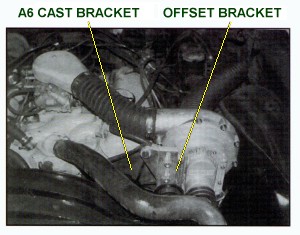
CONSIDERATIONS
To insure that you are among the 90% who are able to fully enjoy the benefits of the Universal ProCharger Kit, three basic issues should be considered:
DESIRED BOOST
ATTAINABLE BOOST
PROCHARGER ATTACHMENT AND OFFSET
DESIRED BOOST
The amount of boost that should be dialed in is primarily determined by your engine's compression ratio and the type of fuel which will be used. For street applications (i.e. pump gasoline) with a compression ratio between 8:1 and 10:1,boost levels should be in the 6-12 psi range, and will generate approximately 30-60% more horsepower. Compression ratios below 8:1 can usually handle 12-15 psi of boost on pump gasoline, and will generate approximately 60-80% more horsepower. With racing fuel, gains exceeding 100% are possible on lower compression motors. Compression ratios above 10:1 are often used, but generally only at lower boost levels.When considering the potential reliability of your supercharged engine, you should be most concerned with detonation, which can result in blown head gaskets and engine destruction. For applications which will run boost and/or compression levels above those mentioned previously, the use of intercooling, ignition retard, water injection, racing fuel and other solutions can eliminate or significantly reduce the risk of detonation.
ATTAINABLE BOOST
The boost which will actually be reached in a given engine is determined by engine airflow and supercharger airflow. Engine airflow reflects both engine size and volumetric efficiency (how well an engine breathes), while supercharger airflow reflects supercharger maximum airflow, pulley sizes and belt slippage. Boost is a measure of the pressure in psi inside the intake manifold given both engine and supercharger airflow. Regarding supercharger maximum airflow, the P600 ProCharger flows enough air to generate approximately 600 horsepower on pump gas and 800 horsepower on racing fuel, Applications which will exceed these figures should consider the P1200 or D-Series ProChargers. Engine airflow, pulley sizes and potential belt slippage together determine how much boost is actually achieved if supercharger maximum airflow is not an issue. For example, a 454 with average volumetric efficiency using a single Vbelt and a moderate drive ratio will generate approximately 6 psi of boost and 500 horsepower on pump gas. The final issue is belt slippage, as drive systems with greater surface contact area (and therefore greater traction) will be necessary to reduce belt slippage and create higher boost levels on a given engine. The three drive systems offered by ATI, in order of increasing belt traction, are the single V belt drive, twin V belt drive, and 8 rib drive. ATI drive Systems may not work with every application; however, it is also possible to have these drive systems fabricated by your local shop. Refer to the documents, "Drive System Basics" and "Boost Specifications Table", to determine drive system, pulley sizes and appropriate boost for your application.
PROCHARGER ATTACHMENT AND OFFSET
 The ProCharger utilizes two of the four factory A6 brackets: the cast bracket,
which bolts to the head; and the flat bracket, which bolts between the cast bracket and
the ProCharger. The rear brackets are not used. If your engine compartment is compatible
with use of the A6 air conditioning brackets, and you do not plan to operate your a/c,
attachment is not an issue. If you cannot use the A6 brackets or you plan to operate your
a/c, you will need to verify that you have a location within your engine comparttnent for
the ProCharger, and then find a local shop which can machine some brackets for you. Offset
is concerned with adjustment of the ProCharger's location as required by your engine
compartment. This adjustment is done with an offset bracket, which replaces the A6 flat
bracket and provides adjustment of the ProCharger's location in two directions: up and
down (for hood clearance) and side to side (for valve cover clearance). For example, if
you have no problems with hood or valve cover clearance you will not need an offset
bracket and will simply use the A6 flat bracket. If you need hood clearance you will need
an offset bracket which provides a downward offset from the ProCharger's location when
using the A6 flat bracket. Please note that ATI has carbureted brackets only for Chevrolet
and 5.0 Mustang applications; for other applications consult your local garage or machine
shop for creation of the necessary offset bracket.
The ProCharger utilizes two of the four factory A6 brackets: the cast bracket,
which bolts to the head; and the flat bracket, which bolts between the cast bracket and
the ProCharger. The rear brackets are not used. If your engine compartment is compatible
with use of the A6 air conditioning brackets, and you do not plan to operate your a/c,
attachment is not an issue. If you cannot use the A6 brackets or you plan to operate your
a/c, you will need to verify that you have a location within your engine comparttnent for
the ProCharger, and then find a local shop which can machine some brackets for you. Offset
is concerned with adjustment of the ProCharger's location as required by your engine
compartment. This adjustment is done with an offset bracket, which replaces the A6 flat
bracket and provides adjustment of the ProCharger's location in two directions: up and
down (for hood clearance) and side to side (for valve cover clearance). For example, if
you have no problems with hood or valve cover clearance you will not need an offset
bracket and will simply use the A6 flat bracket. If you need hood clearance you will need
an offset bracket which provides a downward offset from the ProCharger's location when
using the A6 flat bracket. Please note that ATI has carbureted brackets only for Chevrolet
and 5.0 Mustang applications; for other applications consult your local garage or machine
shop for creation of the necessary offset bracket.